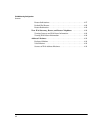
3-21
IPv6 Addressing
Multicast Application to IPv6 Addressing
For related information, refer to:
■ RFC 4291: “IP Version 6 Addressing Archetecture”
■ RFC 2526: “Reserved IPv6 Subnet Anycast Addresses”
Multicast Application to IPv6 Addressing
Multicast is used to reduce traffic for applications that have more than one
recipient for the same data. IPv6 also uses multicast for purposes such as
providing a more defined control of administrative traffic on a VLAN interface
than can be achieved with the broadcast method used by IPv4. This approach
improves traffic control for such purposes as neighbor and router solicita-
tions, router advertisements, and responses to DAD messages. It also avoids
the bandwidth consumption used for broadcasts by narrowing the scope of
possibly interested destinations for various types of messages.
Overview of the Multicast Operation in IPv6
When IPv6 is enabled on a VLAN interface on the switch, the interface
automatically joins the All-Nodes and Solicited-Node multicast address
groups for each of its configured unicast and anycast addresses. The interface
also attempts to learn of other devices by sending solicitations to additional,
well-known multicast groups, such as the following:
■ all routers
■ all MLDv2-capable routers, if multicast listener discovery (MLD) is
enabled on the interface
■ all DHCP agents (if DHCP is enabled on the interface)
There is a separate, solicited node multicast group for each IPv6 unicast and
anycast address configured on a given interface. These automatically gener-
ated groups are limited in scope to the VLANs on which the node resides.
Where multiple IPv6 unicast or anycast addresses on the same node differ only
in their prefixes, they join the same solicited-node multicast group. Solicited-
Node multicast groups are used, for example, in autoconfiguration. In this
case, a node attempting to autoconfigure a link-local address computes the
solicited-node multicast address for the proposed link-local address, then
sends a Neighbor solicitation to this solicited-node multicast address. If there
is no response from another node, the proposed address is available for use.
For more on Neighbor Discovery, refer to “Neighbor Discovery (ND)” on
page 4-17.


















